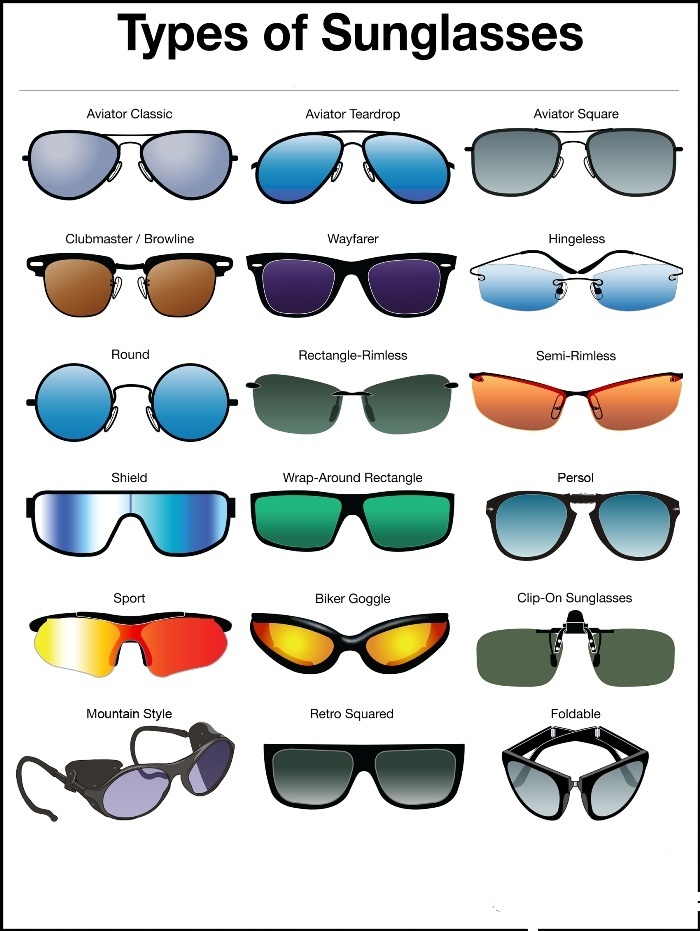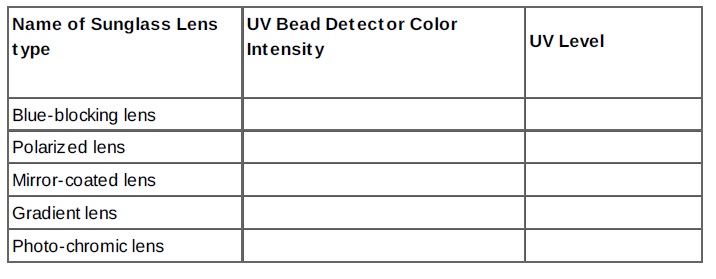





Published on Sep 16, 2023
The objective: Determine which sunglass lens type and/or tints and coatings gives the best sun protection by absorbing ultraviolet (UV) light. Use a UV-Detector to determine the intensity of ultraviolet light that is transmitted through sunglass lens as indicated by the detector. Figure out the best sunglass lens type to reduce the chance of eye damage due to ultraviolet light overexposure.
Why is prolong exposure to ultraviolet radiation (light) harmful to the eyes?
What affect on UV radiation should an effective pair of sunglasses have?
When the UV detector is covered by the lens of a pair of sunglasses and exposed to sunlight if the beads remain white, then the sunglasses are doing what?
Which sunglass lens type was most effective in blocking harmful ultraviolet radiation?
Which sunglass lens type was least effective in blocking harmful ultraviolet radiation?
Is the UV light produced by the Sun able to pass through clouds?
Are dark sunglass lenses more effective at protecting the eyes than light ones?
What safety features are designed into the UV-Bead Detector?
Earth's atmosphere prevents most ult raviolet (UV) radiat ion given off by the Sun from reaching the ground. The radiation tends to be screened out by st rat ospheric ozone, which is about 35 km above the Earth's surface. UV radiation has both positive and negative effects. Positive effects of UV radiation include warmth, light, photosynthesis in plants, and vitamin D synthesis in the human body.
However, too much exposure to UV damages skin cells and leads to wrinkled and patchy skin, cataracts, and even skin cancer. In this activity, you will use a detector composed of two or three UV-beads inside of a clear tube to measure ultraviolet levels. UV-sensitive beads contain phot o-chromat ic dyes that react to UV light and cause the normally white beads to change into vibrant colors when exposed to sunlight. When the detector is shielded from UV radiation, the beads turn purple, even on a cloudy day. As the intensity of UV radiation increases. the color gets darker.
The detector contains a color scale which enables the user to determine the UV index. The job of sunglasses is either to absorb or reflect UV ultraviolet light in order to protect the eyes. This occurs at various stages as the light hits the outside of the lens, the interior of the lens, and the back of the lens. Sunglass lenses are characterized by the specific eye protection that they offer: Blue-blockers block blue light and usually have amber lenses. These lenses are used mostly by skiers, hunters, boaters, and pilots who use them to heighten contrast. Both polariz ed lenses and ant i-reflect ive coat ing lenses minimize reflected glare. Polariz ed lens are generally worn by those who play water and snow sports.
The anti-reflective coating reduces glare caused by light reflecting off the back surface of the sunglass lens. Mirror-coat ed lenses limit the amount of light entering the eyes. They are highly reflective coatings applied to the front surface of the lenses to reduce the amount of light entering the eye. Gradient lenses are tinted from the top down, so that the top of the lens is darkest. Double gradient refers to lenses that are also tinted from the bottom up, so that the top and bottom are darkest and the middle has a lighter tint. Phot o-chromic lenses adjust the level of darkness based on the amount of UV light they're exposed to.
Sunglasses tints do not affect the amount of ultraviolet light that reaches the eyes, and dark sunglass lenses are no more effective at protecting the eyes then light ones; UV protection is completely independent of both color and lens thickness.

Investigator should not look directly at the Sun while using the UV detector as it may cause permanent eye damage, nor stay exposed to the Sun's ray for a prolong time period. The UV Detector tube contains beads pieces that are small which may be considered a chocking haz ard if placed in the mouth. Children under 3 years old should not handle the detector tube.
UV Light Detector
Various sunglass lens types and tints (Blue-blockers lenses, polariz ed lenses, mirror-coated lenses, gradient lenses, double gradient lenses, and photo-chromic lenses)
Empty shoe siz e box
Masking tape
Scissors
1. Cut holes in the shoebox that exactly outline the shape of the sunglass lenses.
2. Place the sunglass lenses over the opening in the box. Make sure sunlight can only enter the box through the lens, seal any crakes and openings with masking tape.
3. Place the UV detector inside and seal the box with tape.
4 . Place the box in direct sunlight. Wait for about 10 to 15 minutes.
5. Open the box, observe and record the color intensity of the beads inside the detector. If the beads remain white, then the sunglasses are blocking harmful ultraviolet rays.
6. Remove the UV-Detector from the box.
7. Place the detector in area where it will not receive sunlight until the beads turn back to white again.
8. Once again place the detector in the box, covering the opening with a different pair of sunglass lens.
9. Place the box in direct sunlight. Wait for about 10 to 15 minutes, observe and record the color intensity of the beads inside the detector.
10. This same procedure should be repeated with all of the sunglass pairs that will be used in this project. Make sure that the box is completely sealed and that the time of sunlight exposure is consistent.
11. Calculate the average UV reduction (if any) for each pair of sunglasses.
12. Record the data in a table similar to the one shown. Use the terms "White," "Light blue," "Medium blue," or "Intense or dark blue" when recording the UV-bead color intensity.

Energiz er.com: Batteries 101 – How Batteries Work
http://www.energiz er.com/learning-center/Pages/how-batteries-work.aspx
How Stuff Works: How Batteries Work
http://www.howstuffworks.com/battery.htm
About.chemistry.com: Factors that Affect the Chemical Reaction Rate Reaction Kinetics
http://chemistry.about.com/od/stoichiometry/a/reactionrate.htm
Schlesinger, Henry. The Battery: How Portable Power Sparked a Technological Revolution. Smithsonian (2010)